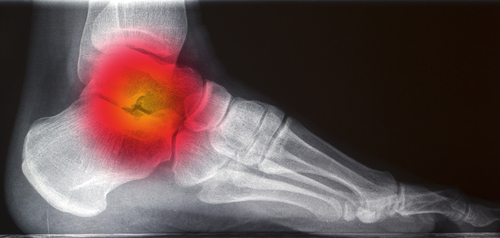Ankle Sprain
Ankle sprain is one of the most common injuries in both athletes and non-athletes. Although normally a minor injury accompanied by moderate pain, and temporary immobility, inappropriate treatment can lead to long term joint issues.[1]
|
Ankle Sprain | |
| Causes | Posture, Sports, Shoes, Injuries |
|---|---|
| See Also | Musculoskeletal Conditions |
| Books | Books on Muscle, Joint and Bone Conditions |
| Articles | Articles on Musculoskeletal Conditions |
Contents
Naturopathic Assessment
Causal Factors
In order to stimulate the innate ability of the body to heal the causes of disease must be identified and addressed. With ankle sprain, the causes are variable and include posture, muscle imbalance, inactivity, and inappropriate exercise management. A detailed assessment is needed to identify external factors and behaviors that may predispose an individual to ankle injury.
Lifestyle
- Nutrient deficiencies can increase the risk of ankle sprains.
- Body Mass
- Individuals with increased body mass may be at increased risk of ankle sprain.[2]
- Poor posture increases the risk of ankle sprains.
External
- Sports
- Ankle injuries are a common sports injury. Sports with the highest rates of ankle sprain include basketball, ice skating, and soccer.[1]
- Footwear
- There is some evidence that the use of shoes with air cells during sport may increase the risk of ankle sprain.[1]
- High-heeled shoes can increase the risk of ankle sprains.
Diagnostic Testing
Ankle sprain is most commonly a clinical diagnosis. The Ottawa Ankle and Foot Rules are a set of criteria used to determine if radiography is necessary in cases of ankle and foot injury. Criteria included in the Ottawa rules include bone pain, inability to bear weight after injury and in the prescence of a doctor. In general, examination immediately post-injury may be less effective and need to be repeated in 48 hours after swelling subsides.[1]
Related Symptoms and Conditions
Ankle sprain is often associated with the following conditions:[3]
- High ankle sprain (sydesmotic sprain)
- Osteochondral fracture of talar dome
- Lateral talus fracture
- Fracture of fifth metatarsal
- Peroneal tendon injury
- Subtarlar joint instability
Characteristics
Up to 85% of ankle sprains are lateral ankle sprains, with the remaining 15% of sprains either medial or syndesmosis (also known as high ankle sprains). Lateral sprains are most often caused by an inversion ankle injury, and typically involves the anterior talofibular ligament if the foot is plantar-flexed at the time of injury, or the calcaneofibular ligament if the foot is dorsi-flexed. Commonly ankle sprains present with swelling, bruising, decreased motion, and inability or decreased ability to weight bear.[4]
Ankle Sprains are graded as follows:[3]
- Grade I – partial tear with no laxity, mild swelling
- Grade II- partial tear with mild laxity, moderate pain, tenderness, instability
- Grade III- complete rupture, considerable swelling, increased pain, laxity, unstable joint
The Common Symptoms indicating an ankle sprain include:[3]
- Edema (swelling)
- Bruising (ecchymoses)
- Decreased range of motion
- Joint instability
Naturopathic Treatment
The goal of naturopathic treatment is to support and work in tandem with the healing power of the body and to address the causal factors of disease with individual treatment strategies. Ankle sprain is typically an acute issue for affected individuals and needs acute treatment to reduce pain and increase function, as well as modification of long-term risk factors.
It is always advisable to work with a naturopathic doctor before engaging in any treatment plan.
Lifestyle
Lifestyle recommendations include:
- Lace up or semi-rigid support has been shown to be effective in shortening return to sport and/or work.[1]
- Individuals with a history of ankle sprain have been shown to benefit from preventative use of external ankle supports during sport.
Naturopathic Therapies
Naturopathic Therapies for ankle sprain include:
- Botanical remedies such as Turmeric (Curcuma longa), Boswellia (Boswellia serrata), Ginger (Zingiber officinale)
- Gemmotherapies including Ampelopsis veitchii, Sequoia gigantea, Pinus montana, Ribes nigrum
- Homeopathic remedies such as Arnica, Ruta
- Acupuncture can assist with the healing of ankle sprains.
- Cryotherapy
- Direct application of ice has been shown to decrease pain and swelling associated with ankle sprain.[1]
- Functional Treatment
- Functional treatments including exercises to restore motion graduating to sport specific drills, have been shown to be significantly more effective than immobilization in ankle sprain.[1]
References
- ↑ 1.0 1.1 1.2 1.3 1.4 1.5 1.6 1.7 1.8 Ivins D (2006) Acute Ankle Sprain: An Update Am Fam Phys 74(10)
- ↑ Fousekis K, Tsepis E, Vagenas G (2012) Intrinsic risk factors of noncontact ankle sprains in soccer: a prospective study on 100 professionals Am J Sports Med 40(8):1842-50
- ↑ 3.0 3.1 3.2 Krabak BJ, Baima J (2008) Frontera: Essentials of Physical Medicine and Rehabilitation 2nd ed Chap 75 Ankle Sprain Saunders
- ↑ Silverstein JA, Moeller J, Hutchinson MR (2011) Rakel: Textbook of Family Medicine, 8th ed Chap 30 Common Issues in Orthopedics Saunders

